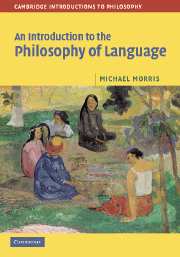Book contents
- Frontmatter
- Contents
- Acknowledgements
- Introduction
- 1 Locke and the nature of language
- 2 Frege on Sense and reference
- 3 Russell on definite descriptions
- 4 Kripke on proper names
- 5 Natural-kind terms
- 6 Quine on de re and de dicto modality
- 7 Reference and propositional attitudes
- 8 The semantics of propositional attitudes
- 9 Davidson on truth and meaning
- 10 Quine and Davidson on translation and interpretation
- 11 Quine on the indeterminacy of translation
- 12 Austin on speech acts
- 13 Grice on meaning
- 14 Kripke on the rule-following paradox
- 15 Wittgenstein on the Augustinian picture
- Glossary
- Works cited
- Index
8 - The semantics of propositional attitudes
Published online by Cambridge University Press: 05 June 2012
- Frontmatter
- Contents
- Acknowledgements
- Introduction
- 1 Locke and the nature of language
- 2 Frege on Sense and reference
- 3 Russell on definite descriptions
- 4 Kripke on proper names
- 5 Natural-kind terms
- 6 Quine on de re and de dicto modality
- 7 Reference and propositional attitudes
- 8 The semantics of propositional attitudes
- 9 Davidson on truth and meaning
- 10 Quine and Davidson on translation and interpretation
- 11 Quine on the indeterminacy of translation
- 12 Austin on speech acts
- 13 Grice on meaning
- 14 Kripke on the rule-following paradox
- 15 Wittgenstein on the Augustinian picture
- Glossary
- Works cited
- Index
Summary
Key texts
Saul Kripke, ‘A Puzzle about Belief’, in A. Margalit, ed., Meaning and Use (Dordrecht: Reidel, 1979), pp. 239–83; Donald Davidson, ‘On Saying That’, in his Inquiries into Truth and Interpretation (Oxford: Oxford University Press, 1984), pp. 93–108.
Introduction
Semantics is the attempt to give a systematic explanation of how the meaning of sentences depends upon the meaning of their parts. Modern semantics began with Frege, whose logical system depends on the semantics of the sentences which can be constructed using its grammar. Frege's semantics was extensional: in general, whole sentences may be swapped when they have the same truth-value, singular terms may be swapped when they refer to the same object, and predicates may be swapped when they're true of the same things.
Propositional-attitude constructions – constructions involving a psychological verb (‘believes’, ‘hopes’, ‘wishes’, ‘fears’, etc.) and a ‘that’-clause – have presented a challenge to extensionalism from the beginning. It's clear that more matters about sentences which occur in such ‘that’-clauses than their truth-value, and it seems that more matters about singular terms which occur here than which object they refer to, and about predicates than which things they're true of. How, then, are we to explain what the words are doing in these ‘that’-clauses? How can we provide a semantics for propositional-attitude constructions?
- Type
- Chapter
- Information
- An Introduction to the Philosophy of Language , pp. 152 - 172Publisher: Cambridge University PressPrint publication year: 2006



